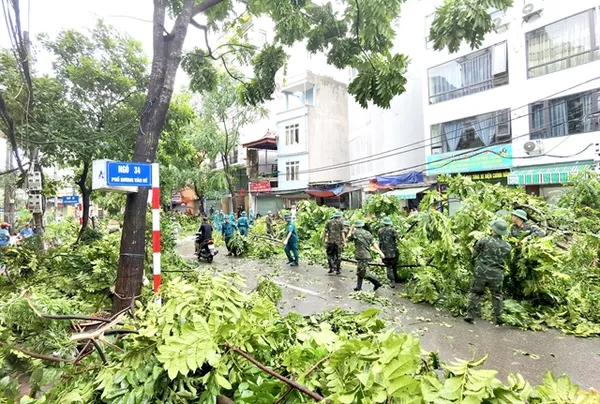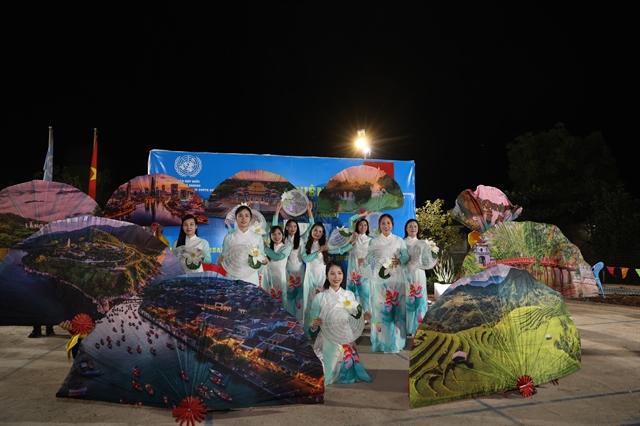 Op-Ed
Op-Ed

 |
| Many trees were uprooted by Typhoon Yagi in Hà Nội.—VNA/VNS Photo |
By Hoàng Sỹ Động
An architect friend, who is originally from Hà Nội, remarked to me, almost reproachfully, that urban areas and green spaces are inseparable. He expressed his dismay at the devastation of Hà Nội’s historic greenery, which was severely damaged by Typhoon Yagi - something he had not witnessed in over 70 years.
Yet, he noted, there has been a conspicuous silence from forestry experts and managers. Though saddened, I had to concede his point.
For some time, Hà Nội has paid insufficient attention to the sustainable development of its green spaces, particularly during the recent period of urban expansion and redevelopment. This neglect is evidenced by violations in protective forest areas, such as in Sóc Sơn District, where the incident involving a famous singer building a villa on protected land sparked outrage. Additionally, the urban greenery in parks, along streets and along the banks of the Red River has faced encroachment.
The removal of two rows of xà cừ (African mahogany, scientific name Khaya senegalensis) trees along Nguyễn Trãi Street went largely unpunished, with only a few voices raised against it and some blaming the species' propensity to shed branches in storms.
In many countries such as the United States or Singapore, such actions would likely result in significant penalties, including imprisonment. The typhoon vindicated the trees, which were marked for removal along Lê Duẩn Street, while many other tree species were uprooted, creating a heart-breaking scene.
The French had meticulously planned and built Hà Nội in the past, resulting in an architectural landscape and greenery that made the city one of the most beautiful in Asia, second only to Tokyo. Reflecting on the 1990s, I recall how two forestry professors from Thailand and Japan were eager to explore Hà Nội’s green spaces when I guided them through various districts, from Hoàn Kiếm District (around Hoàn Kiếm Lake) to Ba Đình District (around the French villa area), Hai Bà Trưng District (Lò Đúc Street and Thống Nhất Park) and Đống Đa District (around the Temple of Literature).
I introduced them to the French's experiments with planting trees in Hà Nội, highlighting that many species had origins beyond Việt Nam, including South America and Africa. The green space around the Vietnamese Presidential Palace rivalled beautiful areas in the former Soviet Union and France, which I have always admired.
Both visitors remarked that Hà Nội's greenery is unique, precious and beautiful, harmonising with the lakes and urban areas alongside European architectural styles that need careful protection and management.
The Japanese professor was particularly intrigued by the teak (Tectona grandis) trees in Thống Nhất Park and remarked on the resilience of sao đen (Hopea odorata Roxb) trees on Lò Đúc Street. The trees survived after the typhoon with only minor branch loss despite their large canopies.
So the question becomes whether Hoàn Kiếm (Sword) Lake would remain picturesque and enchanting without its greenery, especially the lộc vừng (Barringtonia acutangula) trees.
I once reminded a student who was working on a thesis titled 'Sustainable Management of Greenery around Hoàn Kiếm Lake' in the early 1990s, that it was crucial to assess the position, role and condition of the trees in relation to urban architecture and the lake itself. The student then excelled in their report.
Recently, I travelled from Đống Đa District to Tây Hồ District, observing many newly planted trees that had fallen due to uprooting after the super typhoon Yagi. Việt Nam Television’s VTV1 channel reported that around 10 per cent of trees in Hà Nội had been uprooted or broken after the typhoon. I want to add that 80 per cent of the trees have been planted in the last decade.
The planting choices often included trees with diameters over 10 cm, unsuitable species along Nguyễn Chí Thanh Street, and poorly executed planting methods, such as shallow holes that barely covered the roots. High-density planting along streets of Nguyễn Chí Thanh, Đại Cồ Việt and Giải Phóng is impractical and wasteful. Furthermore, I have observed that the frequent excavation of sidewalks and streets by authorities damages tree roots, leading to their collapse during storms, which poses serious risks to residents and their property.
I sometimes received invitations from forestry officials or investors to consult on the planning and development of protective forests and special-use forests, including the on-going planning for Hà Nội. I stressed the importance of integrating green space into the plans. Establishing a protective forest and special-use forest system is crucial thanks to their roles in safeguarding biodiversity and providing a buffer for the capital.
The Ba Vì National Park holds significant potential for environmental education and promoting eco-tourism and spiritual tourism in northern Việt Nam, particularly in the Hồng (Red) River Delta region, which the King Lý Công Uẩn described in the 'Edict on the Transfer of the Capital' that: “Đại La Citadel is located in the area between heaven and earth, with the terrain of a coiled dragon and a seated tiger, located in the east, west, south and north; there is a river in front of it and a mountain behind of it. That area is spacious and flat; the land there is high and bright, the people are not submerged in darkness and misery, all things are prosperous and beautiful.”
Having lived in Hà Nội for over 40 years, I lament that the section of the Red River running through central districts and the outskirts remains wild and often hazardous, becoming a dumping ground for waste materials and suffering from significant encroachment. This reflects deficiencies in urban management, exacerbated by construction projects that violate embankment systems while other countries reinforce banks, build roads and plant trees without constricting water flow.
News reports indicate that over 300 lives were lost, and damages amounted to US$1.5 billion during Typhoon Yagi, a situation for which the forestry sector and experts must share responsibility for having allowed deforestation and agreed to convert forests to outdated agricultural practices.
Examining new approved planning projects reveals limited adaptation to climate change in forestry due to the 2019 Law on Planning, which lacks prohibitory clauses, focusing on three stages of planning, implementation and management, with overarching governance not yet effectively managing national forest areas.
When discussing Hà Nội’s greenery, it is a significant oversight to neglect the planting, care, pruning and overall management of urban trees and parks.
For example, in Thống Nhất Park, it is painful to see public park land encroached upon, cut for road extensions such as the section from Nguyễn Gia Thiều to Đại Cồ Việt and the construction of transformer stations that deviated from the park's original plan. Frequent, poorly coordinated alterations to walkways and drainage systems have led to rapid deterioration. The presence of dead fish creates a foul odour. The fish released into all parks’ ponds in Hà Nội should be harvested and processed into animal feed or fertiliser, protecting the environment.
Even worse, the park, established since 1960, has seen its perimeter fence along Trần Nhân Tông street breached and transformed into a place for cheap goods sales, which could easily be conducted at kiosks along the street on weekends.
Parks should serve the public, particularly the elderly and children for recreation and leisurely strolls, however, the management in some parks has violated this fundamental function.
In conclusion, the city needs a comprehensive re-planning effort, encompassing three phases of planning, implementation and management that align with international standards and suit tropical conditions to sustain and develop the valuable and distinctive green space system.
The initial focus should be on the protective and special-use forests in the outer areas, followed by a comprehensive green infrastructure plan for highways, national roads, provincial roads, rural roads and the embankment systems along the Red River, Đuống River, Cầu River, Tích River, Đáy River, Tô Lịch River and Kim Ngưu River, among others.
It is particularly crucial to manage the areas using advanced IT systems and lean governance practices, adhering to stringent management protocols and executing urban tree planting, pruning and care according to standards.
Careful selection of tree species for specific locations, alongside guidelines for tree diameter, height and planting depth and width, must be established.
Immediate action is needed to enforce strict regulations prohibiting violations against the city’s green spaces, with appropriate economic penalties, imprisonment or community service for offenders, as seen in other countries.
** Associate Professor Hoàng Sỹ Động is former Head of the Production Development Department, National Institute for Development Strategy under the Ministry of Planning and Investment.




